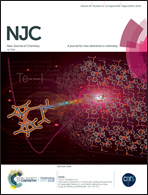Theoretical investigation of the chiral transition of serine and the roles of water, hydroxyl radical and hydroxide ion†
Abstract
We use first-principles density functional theory and ab initio molecular orbital theory to study the chiral transition process of the serine molecule and explore the roles of water, hydroxyl radical and hydroxide ion as catalysis during the interconversion process. The two most plausible chiral transition pathways of isolated serine are identified, in which α-hydrogen is transferred using the amino N atom as a bridge rather than the carbonyl O atom. These two chiral transition mechanisms involve the transformation of chiral enantiomers; in other words, they are serine enantiomerization. Two proton transfer steps with high energy barriers of ∼58.0 and 37.0 kcal mol−1 are the rate-limiting steps. The calculations show that water can effectively catalyze the chiral transition by facilitating efficient proton transport, and the highest energy barriers are ∼26.4 and 4.8 kcal mol−1. The calculations also predict that hydroxyl radical can further lower the energy barriers of the chiral transition to approximately 12.6 and 5.3 kcal mol−1 by facilitating proton transfer. In contrast, hydroxyl radical is more likely to damage serine, and the damage is difficult to repair. Finally, hydroxide ion can further reduce the barriers to chiral transition to approximately 5.5 and 4.5 kcal mol−1 by facilitating proton transfer. As far as we know, this is the first time that these important roles of water, hydroxyl radical and hydroxide ion in serine chiral transition have been demonstrated. The findings provide new insights into the mechanism of serine enantiomerization at the atomic level. Meanwhile, the results show that hydroxyl radical can damage serine, and the damage is difficult to repair.



 Please wait while we load your content...
Please wait while we load your content...